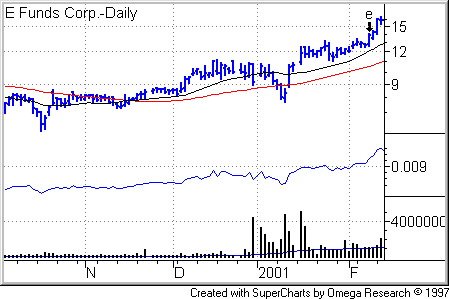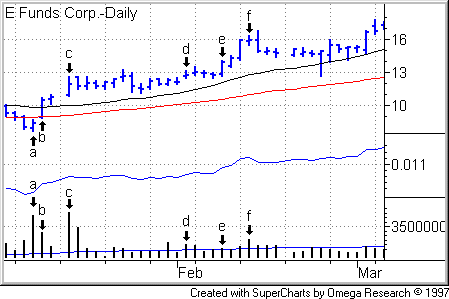Swing-Trading Plays For Intermediate-Term Traders
When practiced under appropriate
market conditions, intermediate-term momentum trading can produce powerful
returns for the disciplined trader. The problem for many traders is you also
must be willing to sit out sideways and highly volatile markets in cash.
This works fine for me. I’ve stuck to
the medium term. However, many successful intermediate-term practitioners also
trade the short term. In strongly trending markets, they’ll play the medium
term, seeking to hold winning positions for weeks to months while also day- and
short-term trading around those positions as well as other stocks. And in
volatile markets, they’ll abandon the medium term and increase their cash
allocation while trading shorter-term moves.
A number of intermediate-term
professionals, including Jim Lacamp and Dave Steckler, have used short-term
tactics for years. Both Jim and Dave have mentioned finding new weapons to their
auxiliary short-term arsenal in Dave Landry’s book, Dave Landry on Swing Trading: A Momentum-based Approach to Capturing Short-term Market Moves.
Many of Dave’s ideas on momentum and entry points come naturally to I-T
chartists. But as I-T traders, we often add in our own seasoning into the soup,
such as relative strength lines and volume clues. As a result, I believe the
future will see a growing contribution of swing and intermediate-term trading
ideas resulting from a careful cross-pollination of ideas from traders in these
two different but complementary disciplines.Â
Again, let me stress that I do not
swing trade myself, although in choppier markets, such as in January-February, I
did bank profits earlier than would be the case in strong-trending markets. I
also want to stress that, if you are learning an intermediate-term strategy, you
should not confuse yourself by studying another style. You should have several
years of successful trading before attempting to add another discipline to your
time frame.Â
I also am against adopting a swing-trading strategy just because you hunger for “action.” This kind of
emotion-driven trading can lead you astray. I know from painful personal
experience, which I describe in my lesson, The
Mindful Discipline of the Medium-Term Trader. Successful traders have
a passion for trading. But unless you’re just fooling around and don’t care
about losses, you should trade to make money, not to scratch an itch. Patience, grasshoppers, patience!
With cautionary preamble, I’d like to
share with you a revealing swing trade by Jim Lacamp,
a vice president at Dain Rauscher in Dallas and superb I-T, as well as his
philosophy about swing trading. Many swing and intermediate-term traders, I
think, will something interesting as Jim marries some of the I-T trader’s favorite tools to a swing setup.
In the future, I’ll share with you
another swing-trading lesson by Dave Steckler,
whom many of you know from his frequent appearance on the Intermediate-Term
Message Board. Â
At the time I’m writing this (May
2001), Jim believes (as I do) that the market has developed sufficient tradable
momentum in the best leadership stocks to play trades out for the medium term.
He traded more swing moves for smaller gains earlier this year. Here was his
reasoning:
” I did a lot more swing trading because up until very recently,
the market did not allow extended moves,” Jim told me. “You’d get stuff that would pop
out and just kind of
drift back. I’ve also begun taking half off the table right after an initial pop.
That would create a situation where half was a swing trade and half an intermediate
trade. But if you were concerned about choppiness, you take that instant profit
right there and then. In a market where leadership seems to be
rotating quickly, swing trading is more rewarding than intermediate-term trading because
outside the retailers
and oil stocks, there weren’t groups making two- to six-month moves, which is
what you want in intermediate-term trade.”
What does Jim look for in swing
trades?Â
“The best swing trades give you a three- to five-point move within two to
three days. What I’ve seen a lot of in these stocks is a hook off a drift, like Landry’s pullback from a new high.
I’ve been looking for that. I’ll look to take profits, particularly if I get two
extended-range days in a row on a swing trade. You don’t want to overstay your visit.
This does two things for you. It’s always providing you with liquidity because you’re getting out of the trades pretty
quickly. And this allows you to
move that money around and go find the next trade, compounding your move.”
Jim will look for stocks that have the
strong technical characteristics that he would seek in an intermediate-term
trade. But in a choppy market, he’ll play the moves for the short term. Let’s
look at a couple of Jim’s swing trades in eFunds Corp.
(
EFDS |
Quote |
Chart |
News |
PowerRating), a provider
of electronic transaction processing and automated teller machine
outsourcing.Â
All charts in the lesson show price
with 20-day (black) and 50-day (red) moving price averages, a relative strength
line (blue) comparing the stock’s performance vs. the S&P 500, and volume
bars with a 50-day moving average line of volume (blue). This first (long-term)
chart uses a logarithmic price scale and shows Jim’s first entry (Point
e). The subsequent (short-term) charts have an arithmetic price
scale.

Right off the bat, the above chart
shows an uptrending stock that corrected and recovered while volume exploded on
a consistent basis well above its norm in the year 2000. “It’s almost like looking at two different
stocks,” Lacamp pointed out. “That tells
me the institutions are getting to know the stock and starting to play it.”
Note the upward-sloping relative strength line, verifying the bullish price
performance, and note how the RS line steepens into Lacamp’s entry (Point
e). “The relative strength line was very powerful. In fact, it
was ramping up. This stock was very powerful in a lousy market.”Â
Now let’s zero in and see how Jim
timed his first entry and exit in this next chart.Â

Note the powerful reversal on strong
volume (Point a) and price advances moves on
strong volume (Points b, c and d) in January
and Feburary 2001. This told Jim that institutions and momentum were coming back
into EFDS. Now comes the time to look for an entry. The stock set new closing
and intraday highs on Feb. 5, then drifted, setting lower highs with volume
staying mediocre and price staying within a tight price range. That’s
constructive consolidation, like a coil tightening up.Â
Jim bought on Feb. 8 (Point
e) as the stock eclipsed the prior-day high. Note that the stock
expanded its price range and closed near the high of the day. Volume, while not extraordinary,
did exceed that of the prior session. So Jim could reasonably conclude that the
shift in character toward great institutional sponsorship remained intact. In
any event, if you wait around for conclusive figures on daily volume, your
target stock could have extended well past your entry point. This applies to
intermediate-term breakout entries as well as other entries. (Sometimes, when I
bring up the importance of volume to Dave Landry, the Pullback King will
reply: “Volume? Volume? What’s that?”)Â
The stock put in two more big gains,
then stopped in its tracks on strong volume (Point f).
Jim already considered the stock extended given the general market character. To
Jim’s eye, that was bearish churning. “Two extended range bars in three
days normally is a sign of a little bit of a blow off in a market that is
spanking stocks after breakouts.” Jim sold and took profits. Not bad for
four days’ work!
Just because you exit a stock doesn’t
mean the game is over. Jim successfully swing traded EFDS three more times.
For The Best Trading
Books, Video Courses and Software To Improve Your Trading
